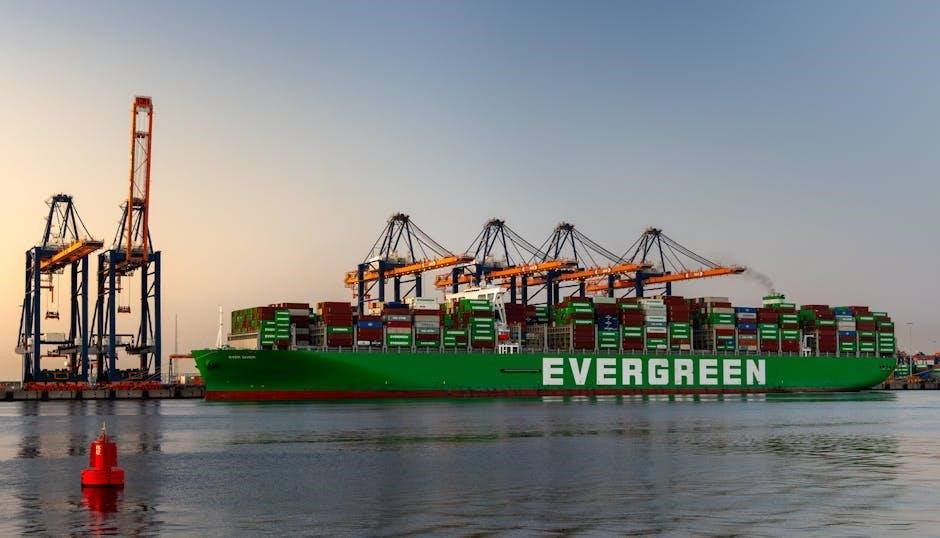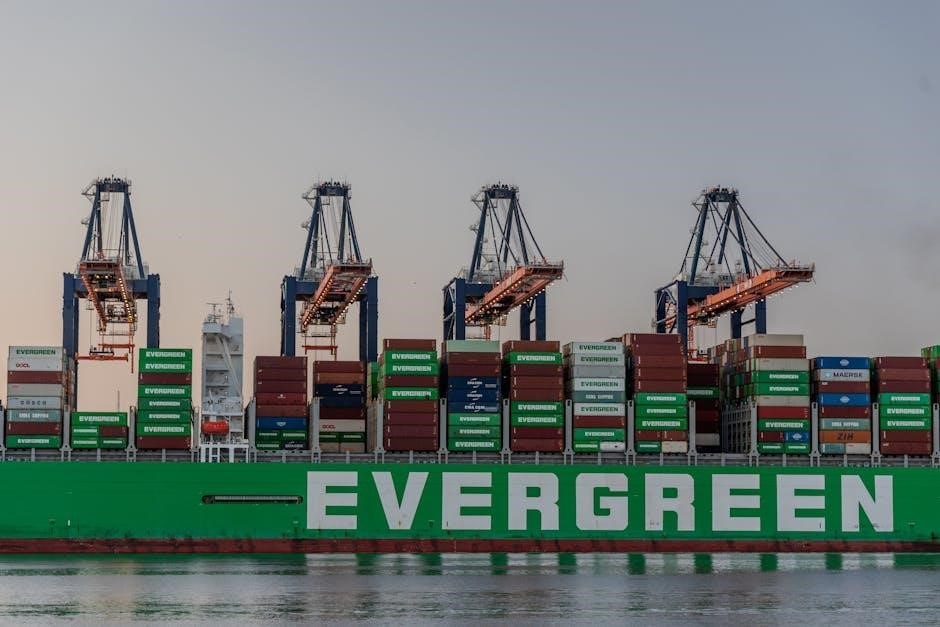Computer ports are essential interfaces connecting devices to computers, enabling data transfer, peripheral connections, and network communication․ They play a crucial role in modern computing, ensuring functionality and expandability․
1․1 Definition and Importance of Computer Ports
Computer ports are physical or virtual interfaces enabling connections between devices and a computer, facilitating data transfer, communication, and peripheral integration․ They serve as gateways for external devices, such as keyboards, printers, and displays, ensuring functionality and expandability․ Ports are vital for establishing network connections, transferring files, and powering devices, making them indispensable in modern computing․ Their versatility allows computers to adapt to diverse hardware and software needs, ensuring compatibility with evolving technologies․ Understanding ports is crucial for optimizing system performance, troubleshooting connectivity issues, and maintaining seamless interaction between devices․
1․2 Evolution of Computer Ports Over Time
Computer ports have undergone significant evolution, adapting to technological advancements and changing user needs․ Early computers relied on serial and parallel ports for data transfer, which were gradually replaced by USB ports for their universal compatibility and ease of use․ The introduction of high-speed interfaces like HDMI, DisplayPort, and Thunderbolt revolutionized video and data connectivity․ Modern ports such as USB-C and USB4 offer multi-functional capabilities, combining power delivery, data transfer, and display connectivity․ This evolution reflects the industry’s shift toward faster, more versatile, and user-friendly designs, enabling seamless integration of devices in an increasingly connected world․

Types of Computer Ports
Computer ports vary widely, serving different purposes such as data transfer, display connectivity, networking, and audio output․ Common types include USB, HDMI, Ethernet, and audio jacks, each designed for specific functions․
2․1 USB Ports (Types A, B, C, and Their Functions)
USB ports are universal connectors for peripheral devices․ Type A is the standard rectangular port, commonly used for keyboards and mice․ Type B is square-shaped, often found on printers and older devices․ Type C, the latest iteration, offers reversible plug orientation and high-speed data transfer, supporting USB4 for faster performance․ These ports are versatile, enabling connections for storage devices, charging, and data synchronization, making them indispensable in modern computing for both functionality and convenience․
2․2 HDMI and DisplayPort for Video Connectivity
HDMI (High-Definition Multimedia Interface) and DisplayPort are critical for video connectivity, enabling high-quality visual output․ HDMI is widely used for connecting devices like TVs, projectors, and monitors, supporting both audio and video․ DisplayPort, commonly found on computers, offers higher resolution and refresh rate capabilities, ideal for gaming and professional displays․ Both ports ensure seamless visual experiences, with HDMI being more prevalent in consumer electronics and DisplayPort favored for its advanced performance in PC setups․ They are essential for configuring multiple monitors and enhancing visual productivity․
2․3 Ethernet (RJ-45) Ports for Networking
Ethernet (RJ-45) ports are essential for establishing wired network connections, offering reliable and high-speed data transfer․ These ports support speeds of 10, 100, or 1000 Mbps, depending on the cable and hardware․ Found on computers, routers, and switches, they enable stable internet access, file sharing, and communication between devices․ Unlike Wi-Fi, Ethernet provides a consistent connection with lower latency, making it ideal for gaming, streaming, and professional environments․ RJ-45 ports are a cornerstone of local area networks (LANs), ensuring secure and efficient communication across connected devices, and are widely used in both home and enterprise settings․
2․4 VGA and DVI Ports for Legacy Displays
VGA (Video Graphics Array) and DVI (Digital Visual Interface) ports are legacy connectors primarily used for connecting older displays, monitors, and projectors․ VGA, an analog interface, supports resolutions up to 1080p, while DVI offers both analog and digital signals, supporting higher resolutions like 1080p and beyond․ These ports are commonly found on older computers, projectors, and monitors, providing a reliable way to connect legacy displays․ However, with the rise of HDMI and DisplayPort, VGA and DVI ports have become less common in modern devices, though they remain essential for supporting older hardware and ensuring compatibility with traditional display systems․
2․5 Audio Ports (3․5mm Jacks, Optical, and Coaxial)

Audio ports such as the 3․5mm jack, optical, and coaxial ports enable high-quality sound output and input connections․ The 3․5mm audio jack is universally used for headphones, speakers, and microphones, offering versatility for analog audio․ Optical ports utilize light to transmit digital audio signals, ideal for home theaters and surround sound systems․ Coaxial ports support digital audio and are commonly used for connecting devices like Blu-ray players and gaming consoles․ These ports ensure superior sound quality and compatibility with various audio devices, catering to both everyday users and audiophiles seeking immersive experiences․
2․6 Serial and Parallel Ports for Legacy Devices
Serial and parallel ports are legacy interfaces historically used for connecting older devices․ Serial ports transfer data one bit at a time, commonly used for modems, mice, and industrial equipment․ Parallel ports, in contrast, transfer multiple bits simultaneously, often used for older printers․ These ports were essential before USB became widespread but have largely been replaced by faster, more versatile technologies․ Despite their decline, they remain relevant in niche applications, such as industrial control systems or retro computing․ Adapters can help maintain compatibility with modern systems, ensuring these legacy ports continue to serve specific needs effectively․

Networking Ports and Protocols
Networking ports and protocols enable efficient data transfer between devices․ Ports like 80 (HTTP) and 443 (HTTPS) manage communication, while protocols such as TCP/IP ensure reliable data delivery․
3․1 Common Port Numbers (20, 21, 22, 25, etc․)
Common port numbers facilitate specific network services․ Port 20 and 21 handle FTP for file transfers, while Port 22 enables secure SSH connections․ Port 25 is traditionally used for SMTP, managing email transmissions․ These standardized ports ensure consistent communication across networks, allowing devices to recognize and interact with services efficiently․ Understanding these ports is essential for configuring firewalls and troubleshooting network issues, as they are fundamental to internet protocols and data exchange․
3․2 Understanding TCP/IP and UDP Port Functions
TCP/IP and UDP ports are crucial for directing data to specific applications․ TCP (Transmission Control Protocol) ensures reliable, error-checked communication, while UDP (User Datagram Protocol) prioritizes speed over reliability․ Both use port numbers to identify applications, enabling efficient data routing․ For instance, web traffic often uses TCP ports 80 (HTTP) and 443 (HTTPS), while online gaming might rely on UDP for faster, real-time communication․ Understanding these protocols and their port functions is vital for network configuration, troubleshooting, and optimizing performance in various applications․
3․3 Firewalls and Port Forwarding Explained
Firewalls act as security barriers, controlling incoming and outgoing network traffic based on predefined rules․ They monitor ports to block unauthorized access while allowing legitimate communication․ Port forwarding enables specific data types to bypass firewall restrictions by mapping external ports to internal IP addresses and ports․ This is crucial for hosting servers, enabling remote access, or facilitating online gaming․ However, improper configuration can expose systems to security risks․ Understanding firewalls and port forwarding is essential for balancing network security and functionality, ensuring safe and efficient data flow․

Peripheral and External Device Ports
Peripheral and external device ports enable connections to keyboards, mice, printers, and storage devices, enhancing functionality and expanding a computer’s capabilities for various tasks and applications․
4․1 PS/2 Ports for Keyboards and Mice
PS/2 ports are legacy connectors used for connecting keyboards and mice to computers․ These ports are color-coded, with purple for keyboards and green for mice․ They were commonly found on older desktop computers before the widespread adoption of USB peripherals․ PS/2 ports provide a reliable, direct connection with minimal latency, making them popular among gamers and typists who prefer the tactile feedback of older input devices․ Despite being largely replaced by USB, PS/2 ports remain supported in many modern computers for compatibility with legacy peripherals․
4․2 Printer and Scanner Ports (LPT, COM)
LPT (Parallel) and COM (Serial) ports are legacy connectors used for connecting printers, scanners, and other older peripherals․ LPT ports, typically labeled as LPT1 or LPT2, were common for parallel communication, transferring multiple bits of data simultaneously․ COM ports, designated for serial communication, transfer data one bit at a time and are often used for industrial devices․ While largely replaced by USB and network connectivity, these ports remain supported in modern systems for compatibility with legacy hardware․ They are usually larger than USB ports and labeled clearly on the computer casing․
4․3 External Hard Drive and Storage Ports
External hard drives and storage devices typically connect through USB, USB-C, Thunderbolt, or eSATA ports․ USB 3․0 and 3․1 offer high-speed data transfer, making them ideal for backups․ USB-C, with its compact design, supports USB 3․2 for faster speeds and versatile connectivity․ Thunderbolt ports, especially Thunderbolt 3 and 4, provide lightning-fast transfer rates, often used for professional storage solutions․ eSATA ports, though less common, are faster than USB 2․0 for external drives․ These ports are essential for expanding storage capacity and ensuring reliable data backups, catering to both casual users and professionals requiring high-performance storage solutions․

Modern and Emerging Port Technologies
Emerging port technologies like USB4 and Thunderbolt 4 offer faster speeds and multi-purpose connectivity․ Wireless solutions and portless designs are gaining traction, enhancing device portability and efficiency․
5․1 Thunderbolt and USB4 for High-Speed Data Transfer
Thunderbolt and USB4 are revolutionizing data transfer with unprecedented speeds․ Thunderbolt 4 supports up to 40 Gbps, enabling simultaneous data and video transfer on up to two 4K displays․ USB4, built on Thunderbolt 3, offers similar speeds and backward compatibility with USB 3․2 and USB 2․0․ Both technologies integrate power delivery, reducing cable clutter․ These ports are ideal for high-performance tasks like video editing and gaming, ensuring faster workflows and enhanced productivity․ Their versatility and speed make them essential for modern devices, catering to growing demands for efficient connectivity in professional and consumer applications․
5․2 The Role of USB-C in Modern Devices
USB-C has become a universal connector, revolutionizing connectivity with its versatility and multi-functionality․ Designed to be reversible, it simplifies plug-and-play convenience․ Supporting high-speed data transfer, power delivery, and display output, USB-C consolidates functionality into a single port; It enables charging for laptops, data transfer for peripherals, and video output for displays, making it indispensable in modern devices․ Widely adopted across laptops, smartphones, and tablets, USB-C streamlines connectivity, reducing clutter and enhancing efficiency․ Its adaptability and compatibility with multiple protocols ensure it remains a cornerstone of future device design, driving innovation in portable and compact electronics․
5․3 Wireless Connectivity and Portless Designs
Wireless connectivity is transforming how devices interact, reducing reliance on physical ports․ Technologies like Wi-Fi 6, Bluetooth, and NFC enable seamless communication, while portless designs emphasize sleek, compact builds․ This shift minimizes clutter and enhances durability, appealing to modern aesthetics․ However, portless devices often require adapters for legacy peripherals, balancing convenience with compatibility․ As wireless standards advance, portless designs are becoming more practical, offering faster data transfer and charging capabilities․ This trend reflects a future where connectivity is effortless and untethered, reshaping how we interact with technology while addressing the challenges of adapting to a world without traditional ports․

Port Identification and Troubleshooting
Identify ports by shape, color, and device compatibility․ Troubleshoot issues like dust buildup or loose connections․ Regular cleaning and testing ensure optimal functionality and performance․
6․1 How to Identify Different Computer Ports
Identifying computer ports involves examining their shapes and labels․ USB ports are rectangular, while HDMI ports are trapezoidal․ DisplayPort is smaller with a flared end․ Ethernet (RJ-45) ports are larger than phone jacks․ VGA ports have screws for securing cables, and DVI ports feature digital connections․ Audio jacks are typically 3․5mm and round․ Serial ports are DB9 or DB25, while parallel ports are larger with multiple pins․ Color coding and symbols near ports also help in recognition․ Proper identification ensures correct device connections, preventing damage and ensuring functionality․ Always refer to your device’s manual for specific port details and purposes․
6․2 Common Issues with Ports and Their Solutions
Common port issues include loose connections, dust accumulation, and physical damage․ To resolve these, clean ports with compressed air and ensure cables are securely connected․ If a port is damaged, consider replacing it or using an adapter․ For software-related problems, reinstalling drivers or checking settings can often fix connectivity issues․ Regular maintenance, such as cleaning and inspecting ports, helps prevent malfunctions․ If a port stops working, try resetting the device or updating firmware․ Always handle ports gently to avoid damage and ensure reliable performance․ Addressing these issues promptly enhances connectivity and maintains optimal device functionality․
6․3 Cleaning and Maintaining Computer Ports
Cleaning and maintaining computer ports is essential for ensuring reliability and longevity․ Use compressed air to gently remove dust and debris, avoiding liquid cleaners that could damage internal components․ For stubborn particles, a soft-bristle brush can be effective․ Regularly inspect ports for corrosion or physical damage, as these issues can disrupt connectivity․ When connecting or disconnecting cables, handle them by the plugs to avoid strain on the ports․ Store unused ports with protective covers to prevent dust buildup․ Proper maintenance prevents malfunctions and ensures optimal performance of connected devices․ Regular cleaning and care extend the lifespan of your computer’s ports․

Setting Up and Using Computer Ports
Setting up computer ports involves connecting peripherals, configuring settings, and ensuring compatibility․ Properly using ports enhances functionality and performance, making your computing experience seamless and efficient․
7․1 Connecting Peripherals to Your Computer
Connecting peripherals to your computer is straightforward when using the right ports․ Identify the appropriate port for your device, such as USB for drives or HDMI for displays․ Plug in the device, and your operating system typically recognizes it automatically․ For printers or scanners, ensure proper drivers are installed․ Always match the connector type to the port to avoid damage․ Properly connecting peripherals enhances productivity and expands your computer’s capabilities, making it easier to work, create, and enjoy multimedia content seamlessly․
7․2 Setting Up a Network Using Ethernet Ports
Setting up a network using Ethernet ports ensures a stable and high-speed connection․ Connect one end of an Ethernet cable to your computer’s RJ-45 port and the other to a router or network device․ Configure your network settings to obtain an IP address automatically or enter it manually if required․ Ensure all devices are connected to the same network for proper communication․ This setup is ideal for reliable internet access, file sharing, and streaming․ Troubleshoot by checking cable connections or restarting the router if issues arise․
7․3 Configuring Display Settings for Multiple Monitors
Configuring display settings for multiple monitors enhances productivity and multitasking․ Connect your monitors to your computer using HDMI, DisplayPort, or VGA ports․ Open your operating system’s display settings to arrange the monitors in your preferred layout․ Use the “Extend” or “Duplicate” options to customize how content appears across screens․ Adjust resolution and orientation for each monitor to ensure optimal display quality․ Ensure all cables are securely connected and drivers are up to date for proper functionality․ This setup allows seamless navigation between screens, ideal for work, gaming, or media consumption․ Proper configuration ensures a smooth and efficient user experience․
Legacy Ports and Their Relevance Today
Legacy ports like PS/2, VGA, and DVI remain relevant for older devices, despite modern alternatives․ They ensure compatibility with vintage hardware, maintaining functionality in niche applications and systems․
8․1 Serial Ports and Their Use Cases
Serial ports, though largely obsolete, remain relevant for specific applications․ They are used for programming microcontrollers like Arduino or Raspberry Pi, industrial automation, and older networking devices․ Additionally, serial ports are employed in hardware debugging, console access for network equipment, and connecting legacy peripherals․ Their simplicity and reliability make them suitable for niche environments where modern interfaces aren’t applicable․ Despite the rise of USB and other high-speed alternatives, serial ports maintain a presence in certain technical and industrial settings, ensuring compatibility with older systems and devices․
8․2 Parallel Ports for Older Printers and Devices
Parallel ports, once common for connecting printers and older peripherals, have largely declined with the rise of USB․ Typically using a 25-pin DB25 connector, these ports transferred data in parallel, offering faster speeds for their time․ They were widely used for dot-matrix printers, scanners, and external drives․ Although obsolete in modern systems, parallel ports remain relevant for niche applications, such as industrial equipment or legacy hardware․ Adapter solutions are often employed to maintain compatibility with newer systems lacking these ports, ensuring continued functionality for older devices in specific environments․
8․3 Adapters and Converters for Legacy Ports
Adapters and converters enable legacy ports to remain functional in modern systems, bridging compatibility gaps․ These devices allow older peripherals, like printers or scanners, to connect via USB-to-serial or USB-to-parallel adapters․ Converters also facilitate connections between legacy video ports (e․g․, VGA) and modern displays (e․g․, HDMI or DisplayPort)․ Additionally, audio jack converters support older sound systems․ These solutions are cost-effective alternatives to replacing legacy hardware, ensuring continued usability without compromising performance․ By extending the life of older devices, adapters and converters are indispensable tools for maintaining functionality in evolving tech environments, offering both practicality and convenience for users with mixed hardware setups․

Port Security and Best Practices
Securing ports involves disabling unused ones, using firewalls, and encrypting data․ Regular audits and updates ensure protection against cyber threats and maintain system integrity effectively․
9․1 Securing Unused Ports on Your Computer
Securing unused ports is crucial for preventing unauthorized access and reducing security risks․ Disable or block unused ports through firewall settings to minimize exposure to potential threats․ Regularly audit and update firewall rules to ensure only necessary ports remain open․ Additionally, use physical security measures, such as port covers, to prevent tampering․ By taking these steps, you can significantly enhance your computer’s security and protect against malicious activities targeting unused ports․
9․2 Protecting Against Port-Based Cyber Threats
Protecting against port-based cyber threats requires proactive measures to safeguard your system․ Hackers often target open or poorly secured ports to gain unauthorized access․ Use firewalls to monitor and block suspicious traffic, ensuring only essential ports remain open․ Enable intrusion detection systems to identify and alert potential threats․ Regularly update software and firmware to patch vulnerabilities․ Encrypt data transmitted through ports to prevent interception․ Additionally, disable unused ports and implement strong authentication protocols․ By adopting these practices, you can significantly reduce the risk of port-based cyberattacks and protect your computer from malicious activities․
9․3 Physical Security for Ports and Cables
Ensuring physical security for ports and cables is crucial to prevent unauthorized access and damage․ Use cable locks to secure USB drives and other peripherals, deterring theft and tampering․ Protect ports with covers or seals when not in use to keep dust and moisture out․ Label cables clearly to avoid accidental disconnections․ Store unused cables in a safe place to prevent them from being misplaced or damaged․ Regularly inspect cables for wear and tear, replacing them if necessary․ Securely anchor cables to prevent tripping hazards․ By maintaining physical control over your ports and cables, you enhance overall system security and reliability․

The Future of Computer Ports
The future of computer ports lies in universal standards like USB-C and wireless connectivity solutions, minimizing physical ports while maximizing efficiency and versatility․
10․1 Trends in Port Design and Connectivity
Modern port design emphasizes speed, versatility, and minimalism․ USB-C and Thunderbolt 4 dominate, offering multi-purpose connectivity for data, display, and power delivery․ Wireless technologies like Wi-Fi 6 and Bluetooth 5․0 are gaining traction, reducing the need for physical ports․ Manufacturers are adopting smaller, reversible designs to save space and enhance durability․ Additionally, the integration of AI-driven port management systems optimizes performance and security․ These trends reflect a shift toward streamlined, high-efficiency devices, catering to the demands of emerging technologies and user preferences for sleek, portable electronics․
10․2 The Shift Toward Universal Ports Like USB-C
The shift toward universal ports like USB-C represents a significant evolution in connectivity․ USB-C’s versatility in supporting data transfer, display output, and power delivery has made it a standard in modern devices․ Its compact design and reversible plug simplify user experience while reducing clutter․ Manufacturers are increasingly adopting USB-C as a multi-purpose solution, phasing out legacy ports․ This trend promotes uniformity across devices, enabling seamless compatibility and reducing the need for multiple adapters․ As technology advances, USB-C’s potential for faster speeds and broader compatibility solidifies its role as the future of universal connectivity, streamlining device design and user convenience․
10․3 Emerging Technologies and Their Impact on Ports
Emerging technologies are reshaping the future of computer ports, emphasizing speed, versatility, and minimalism․ Wireless connectivity options, such as Wi-Fi 6 and Bluetooth 5․0, are reducing reliance on physical ports․ Thunderbolt and USB4 technologies are pushing data transfer limits, enabling faster workflows․ Meanwhile, advancements in display connectivity, like HDMI 2․1 and DisplayPort 2․0, support higher resolutions and refresh rates․ These innovations are driving the adoption of multi-purpose ports, reducing clutter and enhancing device design․ As these technologies evolve, they promise to redefine how ports function, offering users unparalleled efficiency and convenience in connecting and powering their devices․
Computer ports are vital connectors, enabling communication between devices and peripherals․ Their evolution reflects technological advancements, ensuring compatibility and performance․ Understanding ports is crucial for optimizing system functionality and future-proofing setups․
11․1 Summary of Key Points
Computer ports are essential interfaces enabling connections between devices and peripherals․ From USB and HDMI to Ethernet and legacy ports, each serves specific functions․ Modern advancements like USB-C and Thunderbolt offer high-speed connectivity, while networking ports facilitate data transfer․ Peripheral ports support keyboards, printers, and external storage․ Understanding port types, their evolution, and maintenance is crucial for optimizing performance; As technology progresses, universal ports like USB-C are becoming standard, minimizing clutter while maximizing versatility․ Proper port management and security ensure safe and efficient computing experiences, making ports indispensable in both current and future computing setups․
11․2 Final Thoughts on the Importance of Ports
Ports are indispensable in modern computing, bridging the gap between devices and peripherals․ Their evolution reflects technological advancements, from legacy connectors to high-speed interfaces like Thunderbolt and USB-C․ As devices trend toward minimalism, ports remain vital for functionality and adaptability․ Proper maintenance and security ensure longevity and performance, while universal standards like USB-C promise streamlined connectivity․ Ports not only enhance productivity but also future-proof systems, adapting to emerging technologies․ Their role in enabling efficient, secure, and versatile computing experiences underscores their enduring importance in an ever-evolving digital landscape․




















